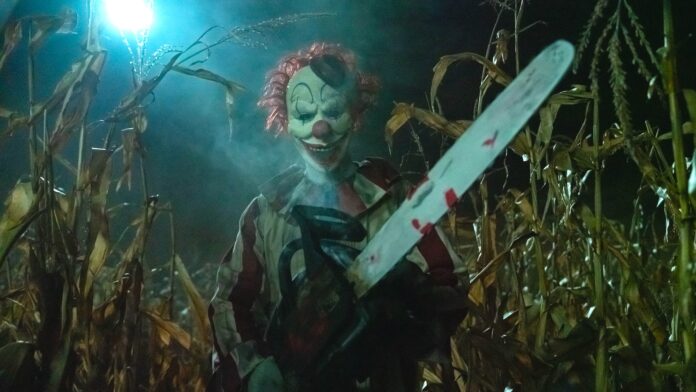Though it was hardly the first movie to satirize slasher-flick conventions, director Wes Craven and writer Kevin Williamson’s original 1996 Scream felt fresh in that it cleverly sent up those cliches in an ironical, fan-savvy way while simultaneously delivering thrills aplenty. That’s a hard balance to achieve—one that even the Scream franchise couldn’t maintain after Scream 2, though it still trundles on. But that equal parts in-jokey-and-bloody mix has gradually turned into a dominating strain for much screen horror, such that these days something like Robert Eggers’ Nosferatu remake can get praised to a large extent simply for taking the genre seriously.
More typical now are recent films like Happy Death Day, M3GAN, Five Nights at Freddy’s, Companion, Heart Eyes, The Monkey, Cocaine Bear, Thanksgiving, and the Terrifier series, which are basically comedies trading in the tropes of prior exercises. Serving up variably gory over-the-top demises on predictable story beats, they’re intended more to amuse than to frighten. Some of them were lively and clever enough to pull that off. But winky self-consciousness as a style requires actual wit—not a tool within every horrormeister’s skillset.
The latest stab (ahem) at a meta-slasher is Clown in a Cornfield, whose title lets you know this it’s going to be a mashup of familiar, borrowed ideas. Thanks to the It and Terrifier films, the clown is now as ubiquitous a screen threat as the vampire or zombie; the Children of the Corn movies (another never-ending series) are just the most obvious examples of agricultural-landscape-as-genre-deathtrap.
This YA-novel-based movie does have cause for high hopes. Its director is Eli Craig, who 15 years ago made Tucker & Dale vs. Evil, which alongside the first two Screams and first Scary Movie remains one of the very few really good slasher spoofs. Things here get off to a reasonable start when the de rigueur gruesome prologue, in which drunken horny youth at a 1991 bonfire party outside a barn meet horrible ends, basically re-stages the opening of Jaws—substituting a cornfield for the ocean, of course.
In present-day Kettle Springs, Missouri, Quinn (Katie Douglas) is an unhappy new arrival, transplanted from Philadelphia by her widowed doctor father (Aaron Abrams)’s new post as general practitioner. Expecting to be surrounded by hicks and dullards—like nice, cute-if-oafish neighbor peer Rust (Vincent Muller)—Quinn is pleased to instead find herself welcomed into a high school in-crowd revolving around Cole (Carson MacCormack), bad-boy scion of the burg’s founding-father family. That clique is, in fact, regarded as delinquents by the local teachers, police, and other authority figures that serve as targets for their sometimes-mean pranks.
Soon their company is getting Quinn into trouble of a standard “why do you hang out with that bad crowd?” nature. But being grounded is the least of her problems once it’s clear that “Frendo” is back—a murderous clown figure embedded in Kettle Springs’ history, and which they’ve revived by staging snarky reenactment videos to post on YouTube. Unfortunately, the mysterious killings commence again in reality, targeting these very same teenage cool kids. Needless to say, Quinn is on the list and her expiration date’s coming up fast.
The young lead actors are appealing enough. But Abrams aside, the adults are all broad yokel caricatures, the portrait of small-town life cartoonish without being particularly funny or original. Ditto the whole suspense plot, the individual deaths, and the heap of convolutedly silly explication that identifies the killer(s) and their motivation at the extended climax (another barn party).
Slick and fun in a disposable way, Clown in a Cornfield ultimately doesn’t have any fresh ideas to rise above the routine slashers it makes fun of. Like those films, it provides passable guilty-pleasure entertainment for 90 minutes or so, then evaporates from the brain. It opens this Fri/9 at Bay Area theaters including SF’s Alamo Drafthouse and Metreon 16.
If you’re looking for kinds of filmmaking that are pretty much the opposite of a generic new mall flick, the San Francisco Cinematheque and Other Cinema at ATA Gallery have long been reliable local sources. Both have intriguing programs on offer the evening of this Sat/10. Under Cinematheque auspices, “Who’s Your True Love?: Films by Karen Yasinsky” at Oakland’s Shapeshifters Cinema will have the artist in person, presenting a nine-film overview of three decades’ work to date.
They range from the stop-motion puppetry of early shorts like Drop That Baby Again (1998) and Boys (2002) to collages of live action, animation, and archival materials that can range from Cultural Revolution artifacts to a baroque Elizabeth Taylor in Boom! Whatever their techniques, these films trade in comedic, ironical and/or indicting contrasts, their playful surfaces belying serious themes.
At Other Cinema in SF’s Mission District, the last installment of a “History From Below” series focuses on music as the expressive medium of underclasses via two recent mid-length documentaries. Jesse Drew and Glenda Egan’s Open Country probes the roots of today’s conservative Nashville pop in “hillbilly” sounds that were often diametrically opposed to exploitative corporate power.
Among the film’s commentators are Hazel Dickens, Utah Phillips, Pete Seeger, Billy Bragg, Jon Langford, and Mat Callahan. The latter, erstwhile frontman for the Bay Area’s own The Looters, contributes Songs of Slavery and Emancipation, an audiovisual accompaniment to his same-named recent book and compact discs exploring resistance ditties that date from shortly after the Revolutionary War through our nation’s Civil War. There will also be a live musical performance from Ian McMahan.
Mention should also be made of Alex Ross Perry’s Pavements, a tribute to the Stockton-born indie rock band that begins playing the Roxie next Tues/13, and which we wrote about when it opened SF Indiefest last February. Unavailable for preview but playing theaters nationwide (including SF’s Opera Plaza and Berkeley’s Elmwood) just this Thu/8 is Tall Tales, an hour-long experimental “fairy tale for the modern world” that’s being released in conjunction with the same-named collaborative album by Radiohead’s Thom Yorke and veteran electronica artist Mark Pritchard.
Stranger than fiction: two new documentaries
A pair of new arrivals to streaming platforms probe familial backstories and secrets that just keep getting weirder and weirder. Maria Fredriksson’s The Gullspang Miracle begins with the director getting approached by two elderly sisters originally from northernmost Norway, who insist she must make a film about the incredible thing that recently happened to them. Wholly by chance, they recently met a peer in Sweden whom they both immediately thought a ringer for a third sibling they believed had committed suicide some years earlier. But did she?
This twisty and bizarre saga finds the three women uncovering a past that includes twins separated to spare them from Nazi medical experiments, possible murder, and more—plus present-day differences in personality and religious belief (or lack thereof) that soon turn this family reunion discordant. When multiple people demand DNA testing to prove—or disprove—their blood ties to one another, you know the shit has hit the fan. While its serpentine narrative leaves many questions still dangling, this Miracle still rewards the curiosity it stirs in bulk. It is now available via On Demand and leading Digital outlets, as well as on Film Movement Plus.
Peter McDowell’s Jimmy in Saigon probes another mystery, that of a much older brother who died when the director was just five years old. Jimmy MacDowell was a seeker who intended to claim conscientious objector status during the Vietnam War, was persuaded out of it by family members, then promptly got drafted and sent overseas. He returned home in 1971, but surprisingly went back to Vietnam as a civilian, writing a friend that his quest there was “to experience hedonistic pleasures like never before.”
His demise a couple years later became a topic no one wanted to discuss. Peter assumed the sibling he barely remembered had died in combat. But was the real cause a drug overdose? A “tropical disease”? Was Jimmy involved in a relationship with a Vietnamese woman, or with her brother?
The filmmaker eventually travels to Southeast Asia twice in search of answers. This is one of those documentaries that becomes a little too much about the frequently onscreen director’s own “journey,” and not quite enough about its ostensible subject. Yet it’s still a fascinating, if also somewhat frustrating, partial glimpse into a short life that covered its tracks pretty thoroughly. Dark Star Pictures releases Jimmy in Saigon to On Demand platforms on Tue/13.





